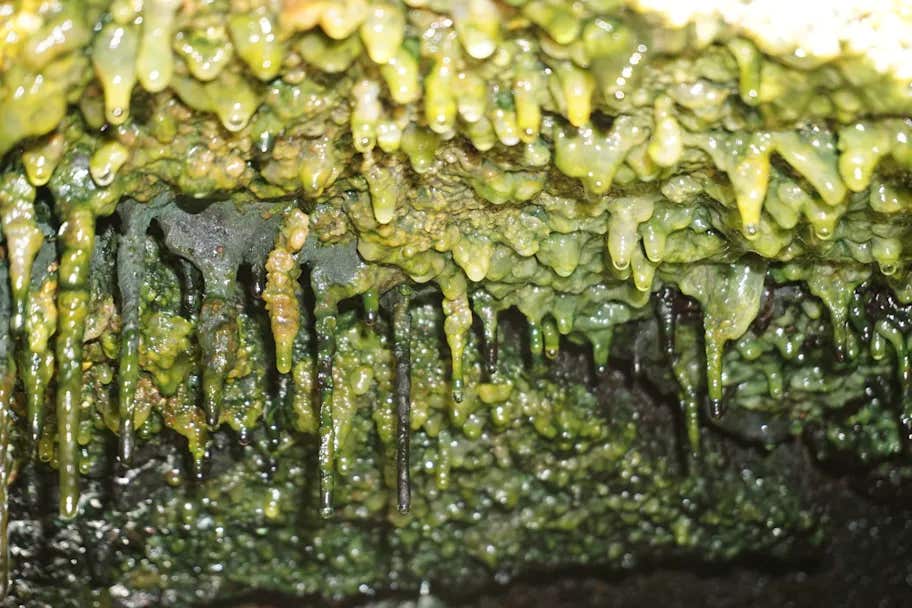Researchers find life thriving deep under the Earth’s surface
Microbes in the deep live in places like ocean trenches and buried rock layers containing extreme heat, crushing pressure, and almost no food.

Thick microbial mats hang under a rock ledge in steam vents that run along the Eastern Rift Zone on Hawaiʻi Island. (CREDIT: Jimmy Saw)
Life thrives far beneath the surface, in places once thought too harsh for survival. In the shadows of Earth’s crust, tiny organisms persist in darkness, pressure, and scarcity. This hidden world pushes the boundaries of where life can exist.
Microbes in the deep live in places like ocean trenches and buried rock layers. These spots come with extreme heat, crushing pressure, and almost no food. Still, life not only survives—it flourishes.
A major global study, led by Emil Ruff of the Marine Biological Laboratory, has uncovered a surprising truth. Microbial communities underground can be just as diverse as those at the surface—or even more so.
Published in Science Advances, the research looked at 1,442 gene datasets and 147 metagenomes from land and sea. It’s one of the first efforts to compare surface and subsurface microbial diversity on a large scale.
“Subsurface ecosystems may host more than half of all microbial cells,” Ruff and his team wrote. The findings challenge what we thought we knew about life’s limits and where its true strongholds might be.
Revealing the Secrets of Microbial Ecosystems
Samples came from deep-sea mud, boreholes, underground aquifers, and fractured rocks. In marine settings, archaea stood out—especially in deep-sea sediments where energy is scarce. On land, caves and groundwater reservoirs offered their own surprising richness of microbes.
These deep organisms live in extreme places: boiling acid springs, frozen permafrost, and miles-deep rock. Their survival depends on clever strategies—enduring on few nutrients and tapping into chemical energy from the Earth itself.
The study also explored “interface environments,” where the surface meets the deep. Areas like hydrothermal vents and deep-sea seeps offered clues about how microbes shift from energy-rich zones to nutrient-poor depths. These transition zones may help scientists understand how life moves—and evolves—between worlds.
Related Stories
By analyzing microbial DNA, the researchers were able to compare the diversity of different environments. They found that while individual surface samples tended to have more microbial species, total diversity in some subsurface environments was just as high, if not higher.
Life in the Darkness
Despite the extreme conditions, subsurface microbes employ various survival strategies. Some reduce their metabolic rates to near-hibernation, dividing only once in decades or even centuries. Others thrive by metabolizing hydrogen, methane, or sulfur, using chemical reactions rather than sunlight to sustain life.
The study identified key microbial groups that dominate subsurface ecosystems. In marine environments, archaea such as Euryarchaeota and Asgardarchaeota were abundant. Euryarchaeota are known for methane production, a process that has implications for both energy research and climate science.
Asgardarchaeota are of particular interest because they share genetic similarities with eukaryotes—the group that includes all plants, animals, and fungi—offering potential clues about the origins of complex life.
In terrestrial subsurface environments, Nitrospirota were common. Some of these archaea oxidize ammonia, playing a role in the nitrogen cycle, while others contribute to human health by reducing harmful nitrogen compounds.
Bacterial diversity was also striking. Proteobacteria, abundant in both marine and terrestrial subsurface habitats, include species that help break down carbon monoxide, a greenhouse gas.
Other subsurface bacteria, such as Desulfobacteria, play a role in sulfate reduction and have applications in environmental remediation. Methylomirabilota, another key bacterial group, help regulate methane levels by oxidizing the gas before it reaches the atmosphere.
One of the most surprising findings was that microbial diversity increased with depth in some environments. This contradicts the expectation that deeper habitats, which have fewer energy sources, would support less life. While marine sediments showed increasing bacterial diversity at greater depths, terrestrial environments exhibited a rise in archaeal diversity with depth.
Implications for Life on Earth—and Beyond
Understanding deep microbial life has broad implications, from biotechnology to planetary exploration. Some of these long-lived microbes may hold clues to extending cellular lifespans, while others could inspire new approaches for carbon sequestration or methane mitigation.
Perhaps most intriguing is the possibility that similar life forms could exist on other planets. Mars, with its dry and radiation-battered surface, might still harbor microbial life deep underground, where water and chemical energy sources could persist.
"Understanding deep life on Earth could be a model for discovering if there was life on Mars, and if it has survived," Ruff said.
Future missions may one day drill deep into Martian rock to search for signs of ancient or even extant life. Until then, Earth's own subsurface remains a frontier full of discoveries waiting to be unearthed.
Note: Materials provided above by The Brighter Side of News. Content may be edited for style and length.
Like these kind of feel good stories? Get The Brighter Side of News' newsletter.



